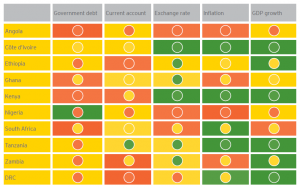Sub-Saharan Africa’s growth forecasts for 2016 have fallen to a two decade low. The World Bank expects growth of 1.6% this year, down from a previous estimate of 2.5%. This continues a pattern of downward forecast revisions this year.
However, beneath the averages and headlines, the growth dynamics across different individual countries and subregions are very mixed. The ‘heatmap’ below provides a snapshot of macroeconomic resilience across some of the key sub-Saharan African economies, and illustrates just how variable economic performance is across different parts of the continent. The color of each block represents the longer-term position for that metric – green being positive and red negative. The color of the circle in the block represents the current trend.
eys-africa-attractiveness-programme-2016-graph
It is clear from this illustration that the three largest economies in sub-Saharan Africa – Angola, Nigeria and South Africa – remain under pressure. In the six months since March 2016, the position of Angola and Nigeria in particular has deteriorated, with the Nigerian economy entering a recession and Angola forecast to register zero growth this year. Sustained low oil prices, and the subsequent deteriorating terms of trade that both economies have experienced since 2014, has led to a growing current account deficit and rising government debt levels.
Although growth in South Africa remains low, there have been some improvements in key macro-economic indicators in the past six months – including the current account deficit and a somewhat stronger currency. This indicates at the very least that the economy has stabilised, and may in fact be a signal of a gradual recovery.

In fact, there are signs that the worst of the economic downturn across the continent may be over, and that growth will recover, albeit gradually. For one, there has been some recovery in commodity prices, and the forecast is for a continued gradual rise in prices. Currencies have been less volatile in many instances (with the exception of Nigeria – for very specific reasons). That in turn has helped contain inflation, which is either slowing or at the very least, holding steady at current levels. This allows for monetary easing, which is supportive of rising consumer spending, and that is critical to the continent’s longer-term growth prospects.
At the same time, and in contrast to challenging economic conditions in the ‘big three’, many of the east African and francophone economies have remained resilient. Kenya, Ethiopia, Tanzania, Côte d’Ivoire and Senegal are among the African economies still expected to grow in the high single digits this year and next (and through 2021). This partly has to do with the major exports of many of these economies being less impacted by declining terms of trade. In addition, investment in infrastructure, domestic consumer spending and the continued evolution of services and manufacturing, continues to spur growth in these economies.
The key to overcoming weak global demand lies in enhancing diversification policies. Economies that span a broad range of sectors tend to fare stronger in such periods. Nigeria and Angola provide strong evidence of reliance on a single commodity, as both economies either face or are already in recession.
The resilience in certain African economies reinforces the need to accelerate the process of diversification in others. Diversification clearly requires structural economic reforms, and each country is at a different point along this path. This provides enormous opportunity for growth across the region, as investors respond to pragmatic policy reforms and seek opportunities across growing consumer, services and industrial sectors.
This article is an excerpt from EY’s ‘Africa Attractiveness Program 2016: Year end update’.



